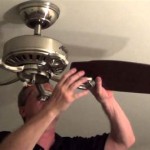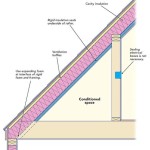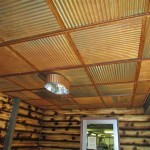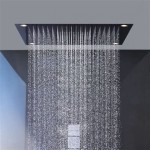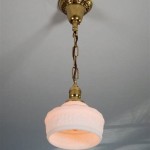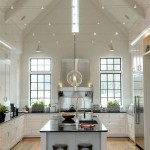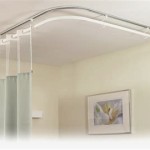How To Install Crown Molding On A Sloped Ceiling
Installing crown molding adds a touch of elegance and sophistication to any room. However, the process becomes significantly more challenging when dealing with sloped ceilings. The angles involved require precise cuts and careful planning to ensure a seamless and professional finish. This article provides a comprehensive guide on how to install crown molding on a sloped ceiling, covering essential tools, techniques, and considerations.
Before embarking on the installation, it is crucial to understand the fundamental challenges presented by sloped ceilings. Unlike standard 90-degree corners, sloped ceilings introduce compound angles that necessitate accurate measurements and specialized cutting techniques. Failure to account for these angles will result in gaps, misalignments, and an unsightly installation. Therefore, meticulous planning and preparation are paramount for a successful outcome.
Essential Tools and Materials
The success of a crown molding installation on a sloped ceiling hinges on having the right tools and materials. Investing in quality equipment will not only simplify the process but also contribute to a more professional and aesthetically pleasing result. Here's a comprehensive list:
*Crown Molding:
Choose the crown molding style and material that best suits the room's aesthetic and your budget. Consider factors such as size, profile, and whether you prefer wood, MDF, or polyurethane. *Miter Saw:
A power miter saw, preferably one with a compound miter capability, is essential for making accurate angled cuts. The larger the saw blade, the better it will handle wider pieces of crown molding. *Coping Saw:
A coping saw is used for making precise cuts on inside corners, particularly when dealing with walls that are not perfectly square. *Measuring Tape:
A reliable measuring tape is crucial for accurately determining the length of the crown molding pieces and the angles of the walls and ceiling. *Angle Finder/Protractor:
An angle finder or protractor is indispensable for measuring the angles of the sloped ceiling and walls. Digital angle finders offer greater accuracy and ease of use. *Stud Finder:
Locating studs behind the drywall is essential for securing the crown molding. A stud finder helps identify these structural supports. *Nail Gun or Finish Nailer:
A nail gun or finish nailer simplifies the process of attaching the crown molding to the walls and ceiling. Alternatively, you can use a hammer and finish nails. *Level:
A level is necessary to ensure that the crown molding is installed straight and even. A laser level can be particularly helpful for longer runs. *Caulk Gun and Paintable Caulk:
Caulk is used to fill any gaps between the crown molding and the walls or ceiling, creating a seamless and professional finish. *Wood Filler:
Wood filler is used to fill nail holes and any imperfections in the crown molding. *Sandpaper:
Sandpaper is used to smooth out any rough edges or wood filler after it has dried. *Primer and Paint:
Primer is applied to the crown molding before painting to ensure proper adhesion and a uniform finish. Choose a paint that complements the room's decor. *Safety Glasses:
Protecting your eyes from sawdust and debris is paramount. *Dust Mask:
Wearing a dust mask prevents inhalation of sawdust and other particles. *Pencil:
A pencil is used for marking measurements and cut lines. *Construction Adhesive:
Construction adhesive provides additional bonding strength between the crown molding and the walls or ceiling. *Clamps:
Clamps can be used to hold the crown molding in place while the adhesive dries.Taking Accurate Measurements and Determining Angles
Accurate measurements and precise angle determination are the cornerstones of a successful crown molding installation on a sloped ceiling. This process requires meticulous attention to detail and a systematic approach.
First, measure the length of each wall where the crown molding will be installed. These measurements will determine the overall length of the crown molding pieces that need to be cut. It is advisable to add a few extra inches to each piece to allow for adjustments and potential errors during the cutting process. These extra inches can always be trimmed off later.
Next, determine the angle of the sloped ceiling. This can be accomplished using an angle finder or protractor. Place the angle finder against the ceiling and the wall, ensuring it is flush against both surfaces. Read the angle measurement displayed on the tool. This measurement represents the angle between the ceiling and the wall. While most ceilings slope in a uniform manner, it's crucial to check the angle at various points to account for any inconsistencies. Record these measurements for each section of the ceiling.
The angle measurements obtained from the angle finder need to be converted into the appropriate miter and bevel settings for the miter saw. This conversion process involves understanding how miter and bevel angles work in relation to crown molding. A common method for calculating these angles involves using a crown molding angle chart or an online calculator specifically designed for crown molding installation. These tools take the measured ceiling angle as input and provide the corresponding miter and bevel angles for both inside and outside corners. It's critical to select the correct type of corner (inside or outside) before performing the calculation.
For instance, if the angle between the ceiling and the wall is 45 degrees, the miter and bevel angles for an inside corner will be different from those for an outside corner. The chart or calculator will provide the specific angles required for each type of corner, ensuring that the crown molding pieces fit together seamlessly.
In situations where the walls are not perfectly square, additional adjustments may be necessary. Walls that are slightly out of square can cause gaps and misalignments in the crown molding. To address this issue, use a coping saw to make slight adjustments to the inside corners. A coping saw allows for precise cuts that can compensate for the irregularities in the walls. Remove small amounts of material from the back of the crown molding until it fits snugly against the wall and ceiling.
After taking all measurements and determining the angles, it is recommended to create a detailed diagram or sketch of the room, indicating the length of each wall and the corresponding miter and bevel angles for each corner. This diagram will serve as a visual guide during the cutting and installation process, minimizing the risk of errors and ensuring a smooth and efficient workflow.
Cutting and Installing the Crown Molding
With accurate measurements and calculated angles in hand, the next step is to cut the crown molding pieces and install them along the sloped ceiling. This process requires precision, patience, and a systematic approach.
Before cutting any crown molding, it is crucial to set up the miter saw with the correct miter and bevel angles. Refer to the previously calculated angles and adjust the saw accordingly. Double-check the settings to ensure accuracy before proceeding with the cut. It is also advisable to practice on scrap pieces of crown molding to verify the accuracy of the angles and to familiarize yourself with the cutting process.
When cutting the crown molding, pay close attention to the orientation of the piece in relation to the saw blade. Crown molding is typically cut upside down and backward, with the bottom edge of the molding against the saw fence and the top edge against the saw table. This orientation ensures that the angles are cut correctly. Refer to the manufacturer's instructions or online resources for specific guidance on cutting crown molding with a miter saw.
For inside corners, it is recommended to use a coping saw to make the final adjustments. The first piece of crown molding for an inside corner should be cut at a 45-degree angle, creating a mitered joint. The second piece should be cut slightly long and then cope-cut to fit snugly against the first piece. Coping involves removing material from the back of the crown molding along the profile line, allowing it to conform to the shape of the first piece. This technique creates a seamless and professional-looking joint, even when the walls are not perfectly square.
Once the crown molding pieces have been cut, it is time to install them along the sloped ceiling. Start by applying a bead of construction adhesive to the back of the crown molding, along the edges that will come into contact with the wall and ceiling. This adhesive will provide additional bonding strength and help to fill any minor gaps.
Position the crown molding piece carefully against the wall and ceiling, aligning it with the marked guidelines. Use a nail gun or finish nailer to secure the crown molding to the studs behind the drywall. Drive the nails at an angle, ensuring that they penetrate the studs. If you are using a hammer and finish nails, be careful not to damage the crown molding.
For longer runs of crown molding, it may be necessary to use multiple pieces. When joining two pieces of crown molding together, create a scarf joint by cutting both pieces at a 45-degree angle. This joint will be less noticeable than a simple butt joint and will provide a stronger connection. Apply construction adhesive to the joint and secure it with nails.
After the crown molding has been installed, inspect it carefully for any gaps or imperfections. Fill any gaps with paintable caulk, using a caulk gun to apply a smooth and even bead. Use a wet finger or a damp cloth to smooth the caulk and remove any excess. Fill any nail holes with wood filler, allowing it to dry completely before sanding it smooth. Finally, prime and paint the crown molding to match the room's decor.
Installing crown molding on a sloped ceiling requires significant effort and attention to detail. By following these steps and taking the time to do the job correctly, it is possible to achieve a professional and aesthetically pleasing result. Remember to prioritize safety and to double-check all measurements and angles before cutting any crown molding. With patience and perseverance, you can transform any room with the elegant touch of crown molding.

Installing Crown Moulding On A Sloped Ceiling Doityourself Com Community Forums

Crown Moulding On Angled Ceiling Sawdust Girl

Installing Crown Moulding Part Two Canadian Woodworking

Installing Crown Moulding On A Sloped Ceiling Doityourself Com Community Forums

Crown Moulding On Angled Ceiling Sawdust Girl

Crown Molding On Angled Ceilings Makely

Installing Crown Molding Around A Cathedral Ceiling Fine Homebuilding

Installing Crown Moulding On A Sloped Ceiling Doityourself Com Community Forums

How To Install Crown Molding On Vaulted Or Cathedral Ceilings The Joy Of Moldings

Install Crown Molding Cathedral Vaulted Ceiling
Related Posts

